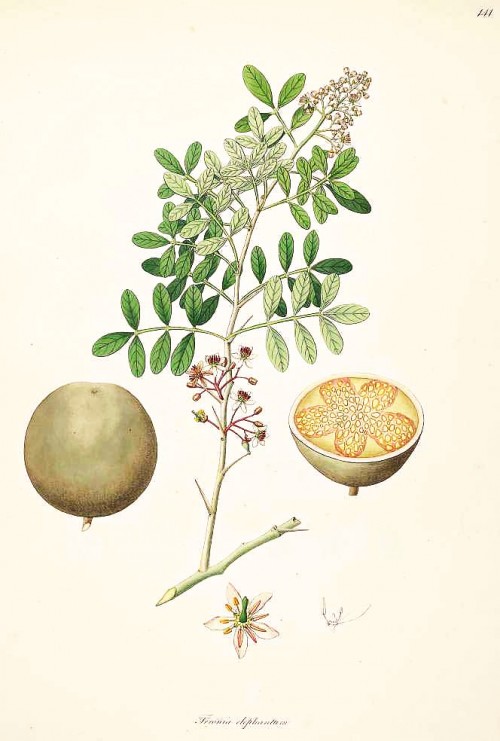Limonia acidissima L. - syn. Feronia elephantum Corrêa; Feronia limonia (L.) Swingle; Schinus limonia L. - Rutaceae
elephant’s apple, (Indian) wood apple, Indischer Holzapfel, Elefantenapfel
Evergreen tree, up to 9m tall, native to Asia (from Sri Lanka, India, Pakistan to China and Malaysia); spines axillary; leaves obovate, entire to obscurely crenulate; flower dull red, fragrant; berry hard, 5-9cm in diameter, with sticky brown pulp and small white seeds inside.
„The 'wood apple' is… frequently cultivated… The leaves smell of aniseed. The pulp of the fruit is used in the treatment of diarrhoea.“
http://www.efloras.org/florataxon.aspx?flora_id=5&taxon_id=220007634
„The fruit is eaten plain, blended into an assortment of drinks and sweets, or well-preserved as jam. The scooped-out pulp from its fruits is eaten uncooked with or without sugar, or is combined with coconut milk and palm-sugar syrup and drunk as a beverage, or frozen as an ice cream.“
http://en.wikipedia.org/wiki/Limonia_acidissima
„The main constituents of the essential oil isolated from F. limonia [Limonia acidissima] leaves were methyl chavicol (27.2%), thymol (24.4%), trans-anethol (10.9%), p-cymen-7-ol (7.3%) and isohumulene (4.8%).“
[Composition of the volatile oil from Feronia limonia leaves., Ahmad, A., Misra, L.N., Thakur, R.S., Planta medica, Vol.55(2), 1989, 199-200]
L.acidissima is used traditionally as diuretic. Methanolic (50%v/v) extract of the leaves at 200mg/kg produced a marked diuresis in treated rats. Significant increase in sodium, potassium and chloride ion excreaction was observed. The diuretic potency was comparable to that of the standard drug furosemide at 100mg/kg.
[Diuretic activity of the extracts of Limonia acidissima in rats., Parial, S., Jain, D.C., Joshi, S.B., Rasayan J Chem, Vol.2, 2009, 53-56]
http://www.rasayanjournal.co.in/vol-2/issue-1/10.pdf
„The fruits of L.acidissima are well documented for its use in Indian traditional medicine and are commonly known as wood apple, elephant-apple, monkey fruit, vilampazham, kath bel and kaitha. The fruits are spherical in shape with greyish-white rind and a woody hard outer shell. L. acidissima fruit pulp is sweet, sticky, brown, resinous, with peculiar aroma and consists of white seeds. The raw fruit pulp is helpful in the treatment of gastro intestinal problems like flatulence, diarrhoea, dysentery and piles.“
The methanolic extract of the pulp contained several fatty acids like docosanoic, dodecanoic, tetradecanoic, penta decanoic acid, octadecanoic, and docosatrienoic acid, e.g. and aroma active substances like maltol, vinyl guaiacol and furan derivatives.
L.acidissima fruit extract showed an antibacterial effect against some clinical pathogens, but at high concentrations compared to ciprofloxacin.
[Spectroscopic analysis and antibacterial effiacy of bioactive compounds from Limonia acidissima L. fruit extract against clinical pathogens., Ponnuraj, S., Jaganathan, D., Kanagarajan, M., Deivamarudachalam, T.P. D., International Journal of Pharmacy and Pharmaceutical Sciences, Vol.7(3), 2015]
http://www.innovareacademics.in/journals/index.php/ijpps/article/download/4711/4711

Roxburgh, W., Plants of the coast of Coromandel, vol.2, t.141 (1798)
http://plantgenera.org/species.php?id_species=605662
